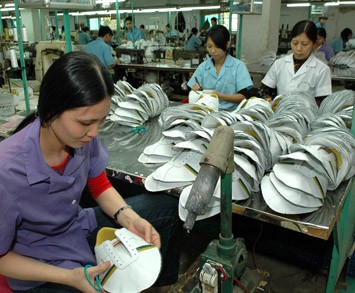(VOVworld) –Vietnam is finalizing the last negotiations with the US to join the Trans-Pacific partnership agreement and is close to signing a Free Trade Agreement with the EU. Meeting requirements for these deals will offer both challenges and opportunities for Vietnam, especially in the footwear sector, to increase exports.
By implementing commitments set by the TPP and FTAs, Vietnamese tannery firms will have opportunities to enjoy a preferential tariff reduced from 14.3% to 0%. This is important for Vietnam’s leather and footwear industry to improve production efficiency and competitiveness, and access advanced technologies and global major brands.
 |
Vietnam’s leather and footwear industry has advantages over low-cost workforce
(Photo: baocongthuong.com.vn) |
More than 500 leather and footwear exporters are operating in Vietnam with a yearly output of up to 500 million pairs. Last year, Vietnam earned 10.32 billion USD from the exports of leather shoes and bags, three quarters of which came from footwear.
Vietnam ranks second in the world after China in footwear production but mainly does processing, with many of its materials being imported. It is a big challenge for Vietnam because once approved, the TPP’s compulsory regulations will be announced on the localization rate for shoe products to be granted with a preferential tariff.
Le Quang Doan, Director of the Minh Minh Dieu Leather Footwear Company, suggested: “the source of leather plays a key role in the sector’s production. I hope the government will pay more attention to policies to help local material makers develop and compete against foreigners in terms of quality and price.”
 |
Vietnam’s tannery sector has been listed as one of the world top 10 exporters of leather shoes.
(Photo: xaluan.com) |
There remains much work for the tannery sector to do to develop sustainably with a focus on the lack of materials and the establishment of material zones. Currently, 119 material and machine producers are serving the industry, 72 of whom have been equitized, while 44 others are foreign invested companies. A number of material suppliers have suggested a closer cooperation between material producers and leather footwear and bag makers by asking them to participate in promotional trade programs.
Realizing pending difficulties, the tannery sector has decided to restructure the industry to match Vietnam’s practical situation and put more investment into their products.
Tran Thanh Quang, a member of the Vietnam Leather and Footwear Association, says: “Many foreign enterprises are looking for Vietnamese partners because China has stopped the processing work. In recent years, although Vietnamese labor costs have increased, the quality of Vietnamese companies has greatly improved, with better market access.”
Since the beginning of this year, Vietnam’s tannery industry has been granted the Generalized System of Preferences for 3 years, under which made-in-Vietnam footwear and bags will enjoy a tariff of 3.5 to 4% instead of 13 to 14% in the past. With such positive changes, the industry’s export target of 12 billion USD for this year is within reach.